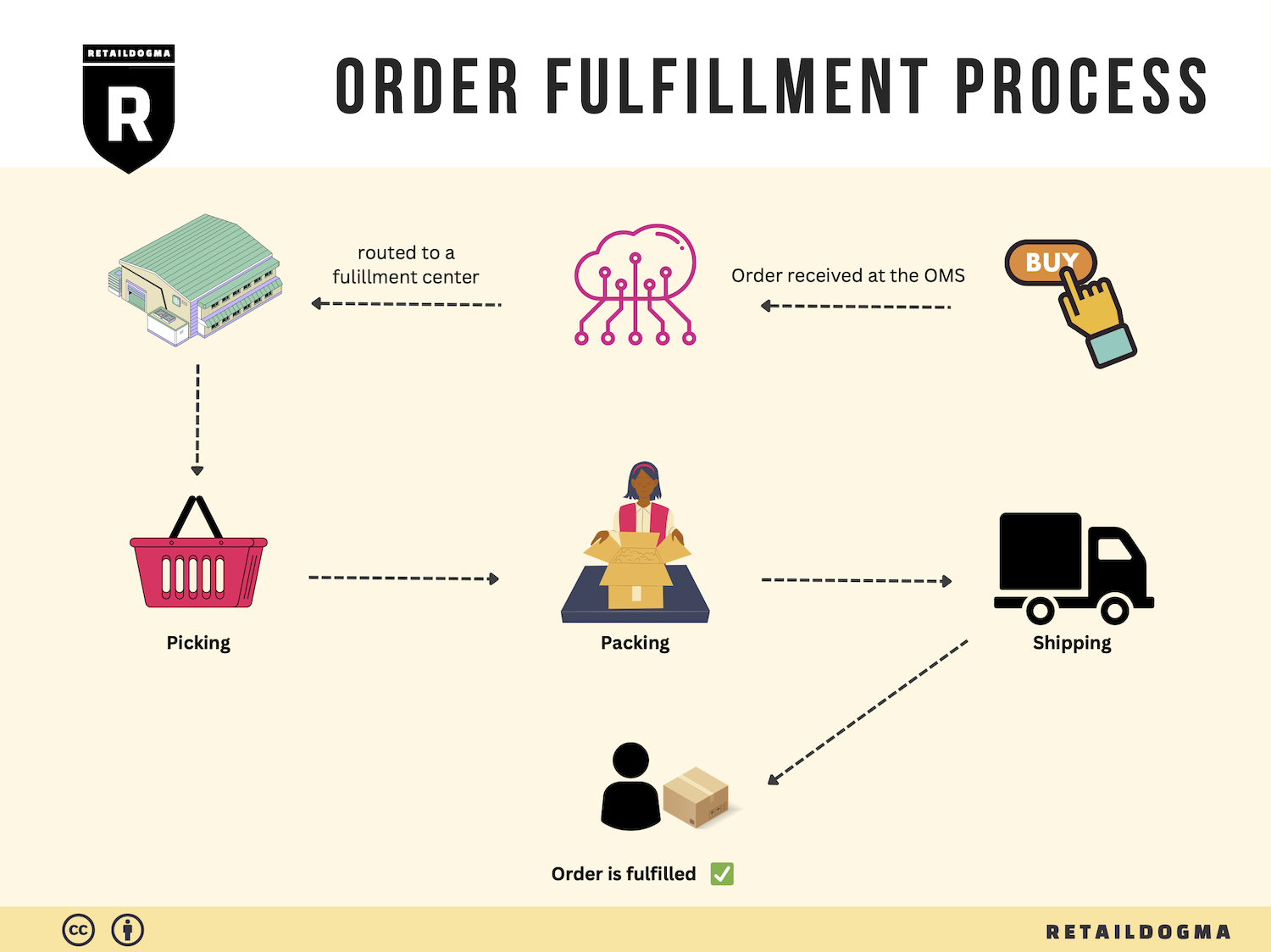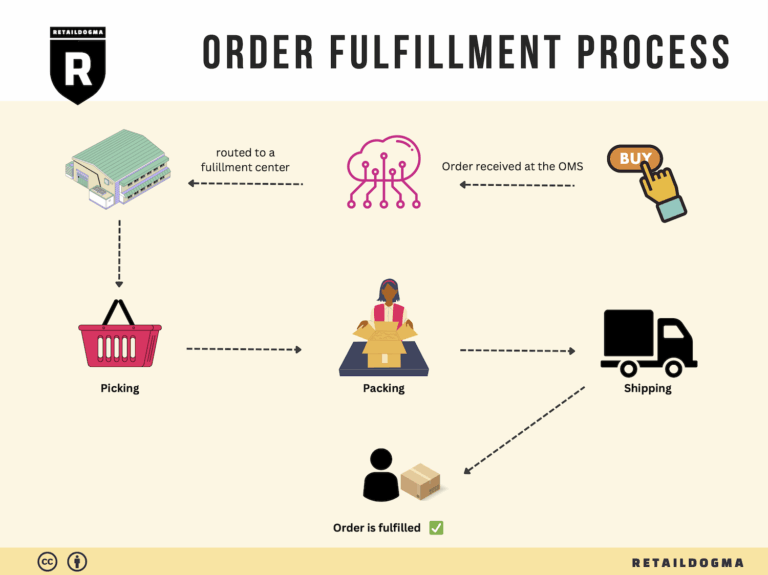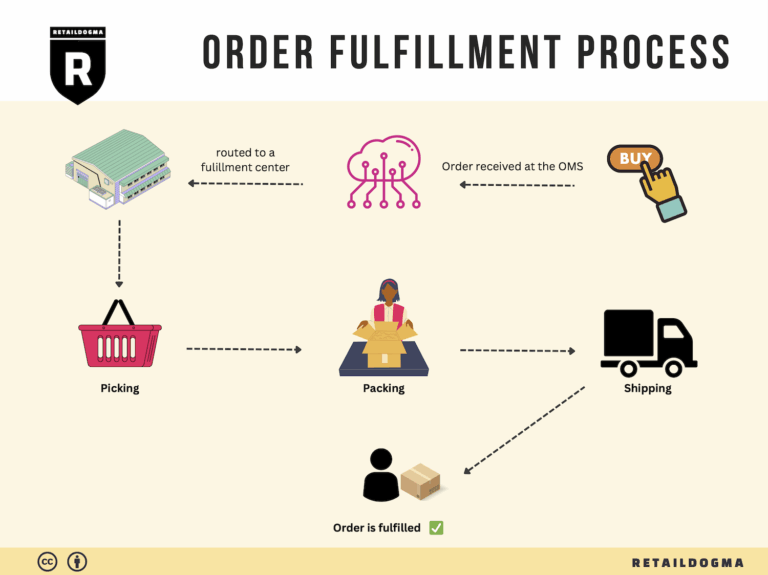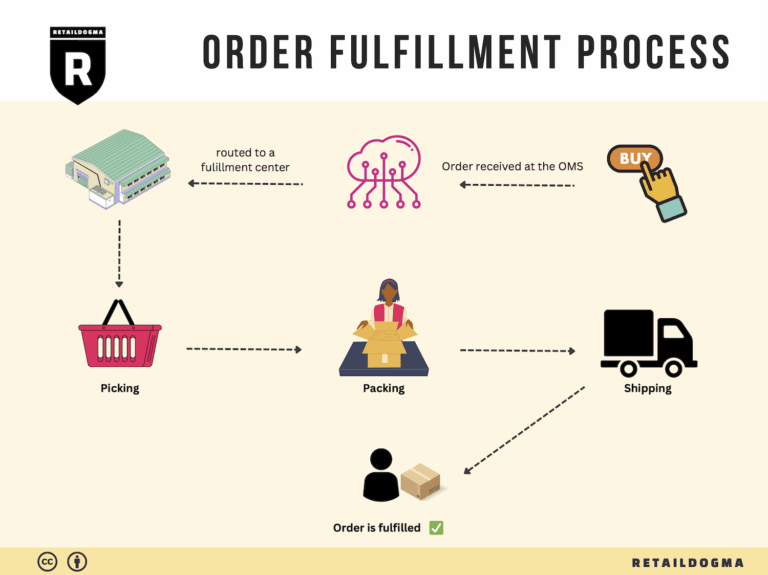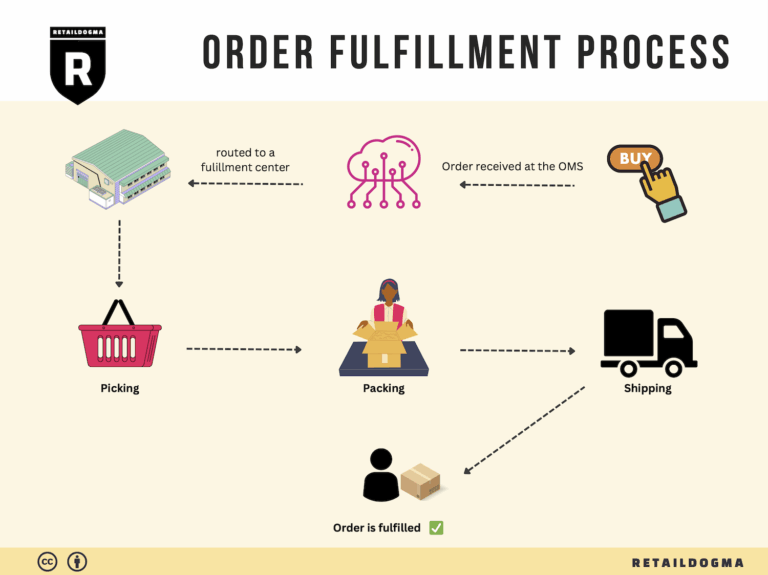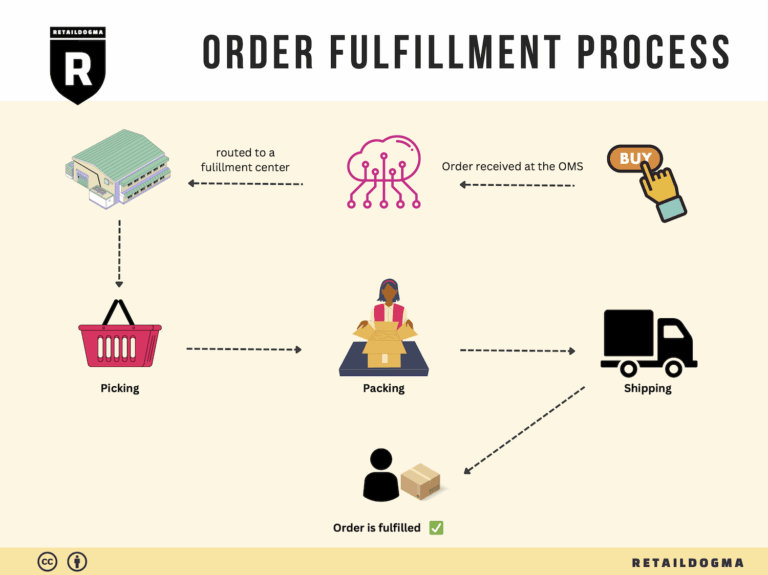Ecommerce Fulfillment Services: The Ultimate Guide (2025)
What is E-commerce Fulfillment? An Introduction for Growing Businesses
Understanding E-commerce Fulfillment
For many growing e-commerce businesses, the excitement of increasing sales can quickly turn into a daunting challenge. As order volumes rise, the process of packing and shipping items can become overwhelming, diverting attention from core business activities like marketing and product development. This is where e-commerce fulfillment comes into play, providing a streamlined solution to efficiently manage the delivery of products to customers.
At its essence, fulfillment refers to the entire process of getting a product into the hands of a customer. This involves a series of logistical steps, including inventory management, order processing, packaging, and shipping. For businesses looking to scale, understanding the nuances of fulfillment is crucial. It can mean the difference between a satisfied customer and a missed opportunity.
In this guide, we will explore various fulfillment models available to e-commerce businesses. You will learn about third-party logistics (3PL), fulfillment by Amazon (FBA), and other options that can help you decide which approach best aligns with your business needs. Each model has its own set of advantages and challenges, and understanding these can empower you to make informed decisions.
We will also delve into the core services offered by fulfillment centers, such as inventory management, order picking, packing, and shipping. These services are essential for maintaining efficiency and accuracy, which are critical for customer satisfaction and retention.
Choosing the right fulfillment partner is another key topic we will cover. Factors like location, technology capabilities, scalability, and customer service play significant roles in ensuring that your logistics operations run smoothly. We’ll provide practical tips on what to look for in a fulfillment partner to support your growth.
Additionally, pricing structures can vary widely among fulfillment providers, so we will break down the costs associated with different fulfillment models and services. Understanding these costs will help you budget effectively and avoid any unexpected expenses.
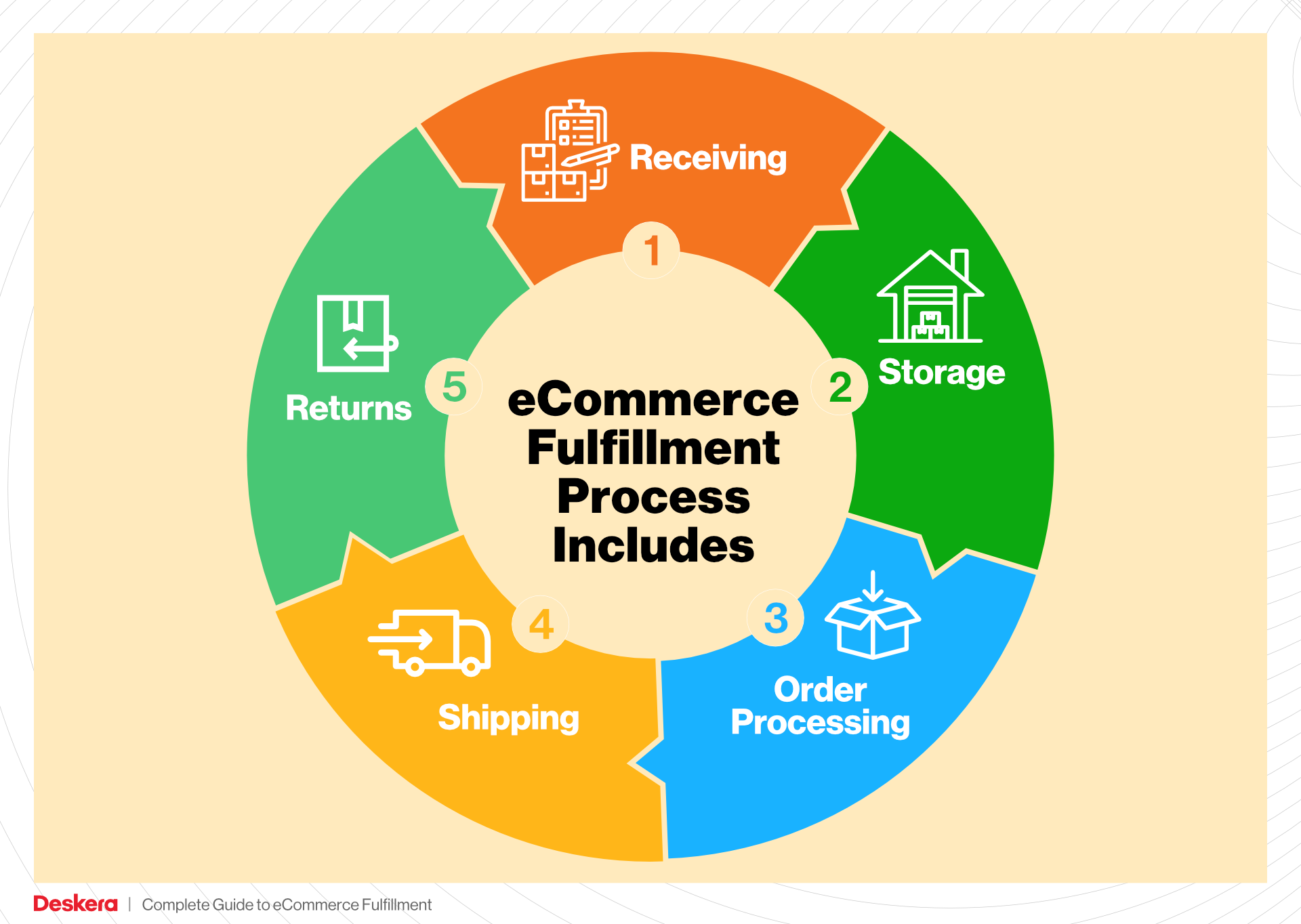
Our ultimate goal with this guide is to empower you as a business owner or operations manager to make smart, strategic decisions about your logistics. By mastering the fulfillment process, you can focus on what you do best—growing your e-commerce business and delighting your customers.
What You’ll Learn In This Guide
- What is E-commerce Fulfillment? An Introduction for Growing Businesses
- The Order Fulfillment Process: From ‘Buy’ Button to Customer’s Door
- Comparing Fulfillment Models: In-House vs. 3PL vs. Dropshipping
- A Deep Dive into Amazon FBA: Pros, Cons, and Who It’s For
- Core Services Offered by Fulfillment Centers
- How to Choose a Fulfillment Partner: A 6-Point Checklist
- Understanding Fulfillment Pricing: A Breakdown of Common Fees
- Frequently Asked Questions (FAQs) about Fulfillment
- Conclusion: Is Outsourcing Fulfillment the Right Move for Your Business?
- Important Disclaimer
The Order Fulfillment Process: From ‘Buy’ Button to Customer’s Door
1. Receiving Inventory
The first step in the order fulfillment process is receiving inventory. When new stock arrives at the fulfillment center, it is critical to verify that the shipment matches the purchase order. This involves checking quantities, inspecting for damages, and ensuring that the correct items have been delivered.
Importance: Efficient inventory receiving is vital as it sets the foundation for accurate stock management and order fulfillment. Any discrepancies at this stage can lead to stockouts or delays in fulfilling customer orders, negatively impacting customer satisfaction.
Key Term: SKU (Stock Keeping Unit) – A unique identifier for each product, which simplifies tracking and management throughout the inventory process.
2. Warehouse Storage
Once the inventory has been received and verified, the next step is warehouse storage. This involves organizing products in a manner that maximizes space and facilitates easy access. Items are often categorized and stored in designated areas based on their type, size, or sales velocity.
Importance: Proper warehouse storage is crucial for operational efficiency. An organized warehouse minimizes the time taken to locate products, thus speeding up the order picking process. Moreover, effective storage strategies can help reduce costs associated with warehousing and inventory management.
Key Term: FIFO (First In, First Out) – A method of inventory management where the oldest stock is sold first, helping to minimize waste and ensure that products are sold while they are still fresh.
3. Order Picking
The third step is order picking, where fulfillment associates retrieve items from storage to fulfill customer orders. This process typically involves using a pick list, which outlines the items and quantities needed for each order. Associates may use various methods, including batch picking or zone picking, depending on the fulfillment center’s layout and order volume.
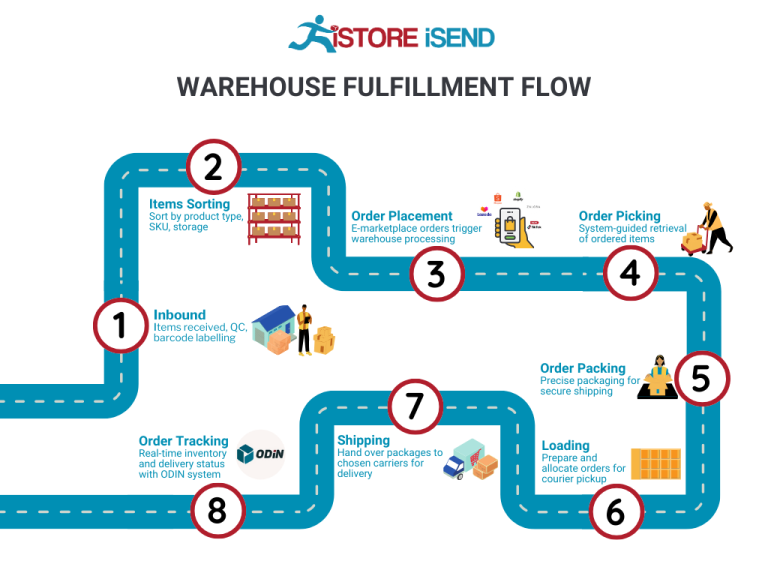
Importance: Accurate order picking is essential for ensuring that customers receive the correct products. Errors in this step can lead to returns, exchanges, and increased operational costs. The efficiency of order picking directly impacts overall fulfillment speed and accuracy.
Key Term: Pick List – A document that lists the items to be picked for an order, including their locations within the warehouse. This tool is essential for guiding associates and ensuring accuracy in order fulfillment.
4. Order Packing
After items have been picked, they proceed to the order packing stage. In this step, fulfillment associates pack the items securely for shipment. This includes selecting appropriate packaging materials, adding packing slips, and ensuring that items are protected against damage during transit.
Importance: Effective packing not only prevents damage but also enhances the customer experience. A well-packed order reflects professionalism and care, which can lead to repeat business. Additionally, efficient packing processes can help reduce shipping costs by optimizing package size and weight.
Key Term: Packing Slip – A document included in the shipment that outlines the contents of the package. It serves as a reference for customers and helps ensure that the correct items have been shipped.
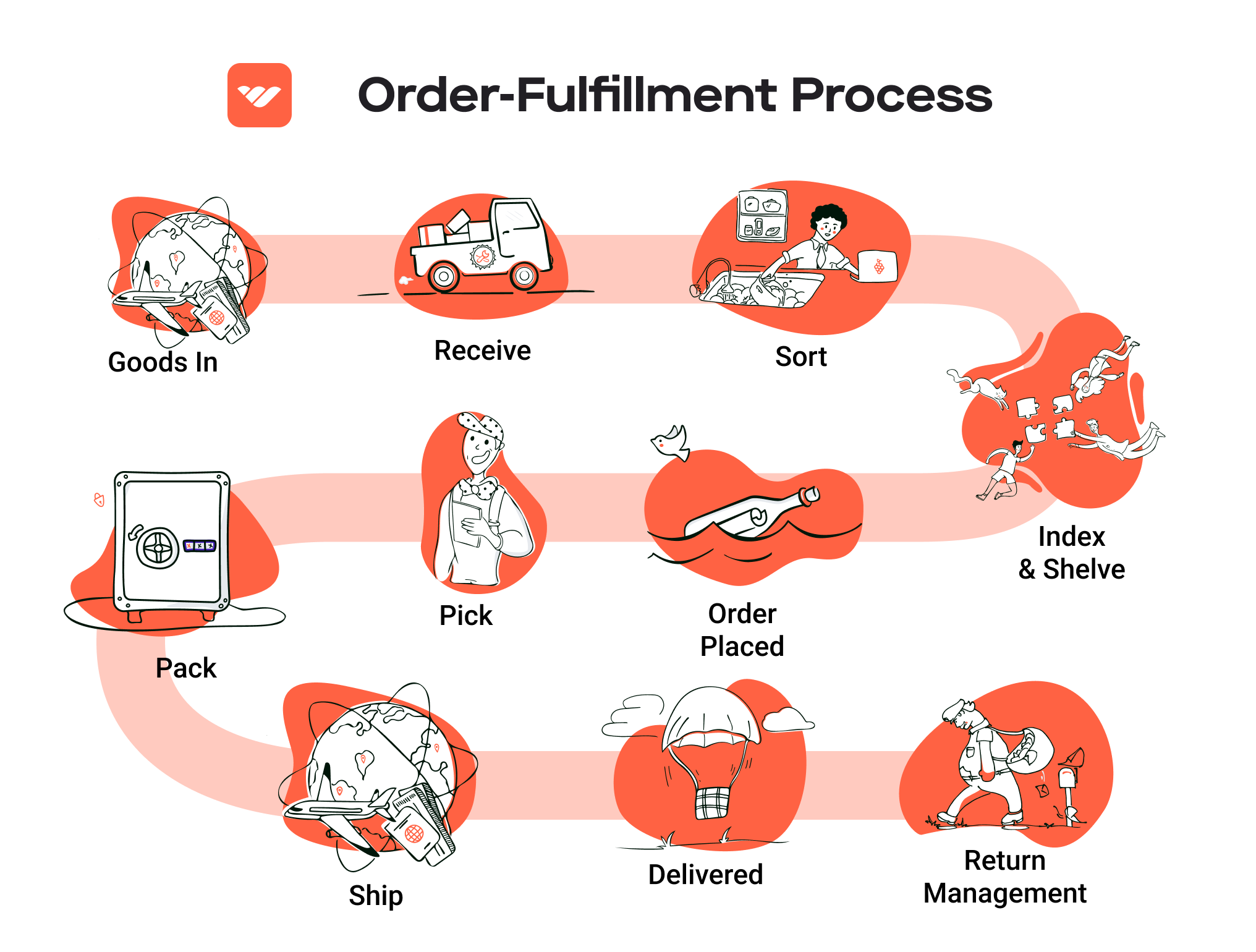
5. Shipping & Delivery
The final step in the order fulfillment process is shipping and delivery. Once packages are packed, they are labeled and handed over to carriers for transportation. This stage involves selecting the appropriate shipping method based on factors such as cost, speed, and destination.
Importance: Timely shipping and delivery are critical for customer satisfaction. Customers today expect fast and reliable delivery, so optimizing this stage can lead to improved customer loyalty and retention. Additionally, tracking shipments and providing customers with updates can enhance their overall experience.
Key Term: Last Mile Delivery – The final step of the delivery process where the package is transported from a distribution center to the customer’s doorstep. This stage is often the most critical, as it directly impacts customer satisfaction and delivery speed.
In conclusion, each step of the order fulfillment process—from receiving inventory to shipping and delivery—plays a crucial role in ensuring that customers receive their orders accurately and on time. By optimizing these processes, e-commerce businesses can enhance operational efficiency, reduce costs, and improve customer satisfaction, ultimately leading to scalable growth.
Comparing Fulfillment Models: In-House vs. 3PL vs. Dropshipping
Comparison of Fulfillment Models
| Model | Who Handles Inventory | Best For (Business Stage) | Key Advantage | Key Disadvantage |
|---|---|---|---|---|
| In-House Fulfillment | Business owns and manages inventory | Established businesses with stable demand | Greater control over inventory and processes | Higher operational costs and resource demands |
| Third-Party Logistics (3PL) | 3PL provider manages inventory | Growing businesses looking to scale | Flexibility and reduced overhead costs | Less control over inventory and fulfillment process |
| Dropshipping | Supplier handles inventory | Startups and small businesses | Low initial investment and risk | Lower profit margins and reliance on suppliers |
In-House Fulfillment
In-house fulfillment involves a business managing its own inventory and order fulfillment processes. This model is typically best suited for established businesses with a stable demand for their products. By handling fulfillment in-house, businesses maintain greater control over their inventory, ensuring that they can quickly adapt to changes in demand, manage quality control, and implement tailored customer service practices. This direct oversight can lead to enhanced customer satisfaction and loyalty, as businesses can address issues more swiftly. However, the key disadvantage is that in-house fulfillment can be resource-intensive, requiring significant investment in warehousing, labor, and technology. Additionally, businesses must manage the complexities of logistics, which can divert focus from core operations and growth strategies.
Third-Party Logistics (3PL)
Third-party logistics (3PL) providers offer businesses the ability to outsource their inventory management and fulfillment processes. This model is particularly advantageous for growing businesses that are looking to scale operations without the significant overhead costs associated with maintaining an in-house fulfillment center. By partnering with a 3PL, businesses can leverage the provider’s expertise in logistics, technology, and distribution networks, which can enhance operational efficiency and reduce shipping times. Moreover, 3PLs often provide flexible solutions that allow businesses to scale their operations up or down based on demand fluctuations. However, the primary drawback is the reduced control over the inventory and fulfillment process, which can lead to challenges in maintaining quality standards and managing customer expectations. Businesses may also face difficulties in communication and coordination with their 3PL partners, particularly during peak seasons.
Dropshipping
Dropshipping is a fulfillment model where the supplier or manufacturer holds the inventory and ships products directly to the customer on behalf of the retailer. This model is particularly appealing for startups and small businesses due to its low initial investment requirements and minimal financial risk. Retailers can offer a wide range of products without needing to purchase inventory upfront, allowing them to focus on marketing and sales. Additionally, dropshipping can provide geographical flexibility, enabling retailers to reach a global customer base without the constraints of physical warehousing. However, dropshipping comes with its own set of challenges. Profit margins are typically lower since retailers rely on suppliers for fulfillment, and they often have less control over product quality, shipping times, and customer service. As a result, issues such as stockouts, shipping delays, and quality discrepancies can adversely impact customer satisfaction and brand reputation.
In conclusion, each fulfillment model presents unique advantages and disadvantages, and the best choice depends on the specific needs, goals, and stage of your business. Understanding these models will empower e-commerce business owners and operations managers to make informed decisions that align with their growth strategies and operational capabilities.
A Deep Dive into Amazon FBA: Pros, Cons, and Who It’s For
Understanding Fulfillment by Amazon (FBA)
Fulfillment by Amazon (FBA) is a service provided by Amazon that allows e-commerce sellers to store their products in Amazon’s fulfillment centers. Amazon takes care of storage, packaging, and shipping of the products directly to customers, allowing sellers to focus on other aspects of their business. The integration of FBA into your business can streamline operations, enhance customer satisfaction, and potentially increase sales.
How FBA Works
-
Product Listing: Sellers first create a listing for their products on Amazon. They can either choose to fulfill orders themselves or opt for FBA.
-
Inventory Shipment: Once a seller chooses FBA, they ship their products to Amazon’s fulfillment centers. Amazon provides guidance on how to prepare and ship inventory, including labeling requirements.
-
Storage: After the inventory arrives at the fulfillment center, Amazon stores it until an order is placed. The seller is charged for storage space based on the size and amount of inventory stored.
-
Order Fulfillment: When a customer places an order for a product fulfilled by FBA, Amazon picks, packs, and ships the product directly to the customer. Amazon also handles customer service and returns for these orders.
-
Payment: After the sale, sellers receive payment from Amazon, minus the FBA fees. These fees can vary depending on the size and weight of the product.
Pros of FBA
-
Prime Eligibility: One of the most significant advantages of using FBA is that products become eligible for Amazon Prime. Prime members enjoy free two-day shipping, which can significantly enhance your product’s visibility and attractiveness, leading to increased sales.
-
Customer Trust: Products fulfilled by Amazon benefit from Amazon’s reputation for reliability and customer service. Customers are more likely to purchase items that are backed by Amazon’s fulfillment service, as they trust the platform for its fast shipping and hassle-free returns.
-
Multi-Channel Fulfillment: FBA is not limited to Amazon sales. Sellers can also use FBA to fulfill orders from their own websites or other e-commerce platforms. This capability allows businesses to centralize their fulfillment processes while leveraging Amazon’s logistics infrastructure.
-
Scalability: FBA allows sellers to scale their businesses without the need for substantial investment in warehousing and logistics. As sales grow, Amazon can handle increased order volumes, enabling sellers to focus on marketing and product development.
-
Time Savings: Outsourcing the logistics to Amazon frees up valuable time for sellers. They can focus on sourcing products, marketing strategies, and customer engagement while Amazon manages inventory and shipping.
Cons of FBA
-
High Fees: FBA comes with various fees, including storage fees and fulfillment fees. These costs can add up, especially for sellers with low-margin products or those with excess inventory. It’s essential to calculate these costs carefully to ensure profitability.
-
Strict Inventory Rules: Amazon has stringent inventory management policies. Sellers must ensure that their inventory is compliant with Amazon’s guidelines, or they risk incurring additional fees or having their inventory removed.
-
Commingling Risks: With FBA, sellers’ products may be stored alongside those of other sellers. This commingling can lead to issues where customers receive the wrong product or damaged items. Sellers may also face challenges in tracking their inventory if it gets mixed with others.
-
Limited Control: By using FBA, sellers relinquish some control over the fulfillment process. Issues such as packaging quality, shipping speed, and customer service are managed by Amazon, which may not always align with a seller’s brand image or customer expectations.
-
Inventory Limits: Amazon imposes limits on the amount of inventory sellers can store in its fulfillment centers, particularly for new sellers. This limitation can hinder growth for businesses that need to scale quickly.
Who is FBA Best For?
FBA is particularly beneficial for:
-
Small to Medium-Sized Sellers: Businesses that lack the infrastructure or resources to manage their logistics can leverage FBA to handle fulfillment efficiently.
-
High-Volume Sellers: Sellers who have a consistent volume of sales can benefit from the economies of scale offered by FBA, as the cost per unit decreases with higher volumes.
-
Brands Seeking to Build Trust: New brands or those looking to improve their credibility can gain customer trust through Amazon’s reputation and Prime eligibility.
-
Multi-Channel Retailers: Businesses that sell on multiple platforms can simplify their fulfillment process by using FBA for all orders, allowing them to manage inventory from a single source.
-
Time-Strapped Entrepreneurs: Sellers who want to focus on growth and marketing rather than logistics will find FBA a valuable solution.
In conclusion, while Fulfillment by Amazon presents several advantages that can aid in scaling an e-commerce business, it is crucial for sellers to weigh these benefits against the potential drawbacks. By understanding the intricacies of FBA, e-commerce entrepreneurs can make informed decisions that align with their business objectives and operational capabilities.
Core Services Offered by Fulfillment Centers
Inventory Management & Warehousing
Fulfillment centers provide comprehensive inventory management and warehousing solutions that are crucial for e-commerce businesses looking to scale. This service involves the systematic storage, tracking, and management of inventory within a warehouse. Fulfillment centers utilize sophisticated inventory management systems that integrate with e-commerce platforms to provide real-time visibility of stock levels, manage stock replenishment, and prevent stockouts or overstock situations.
The benefits of efficient inventory management are manifold. For one, it allows e-commerce businesses to optimize their storage costs by utilizing space effectively. Accurate tracking reduces the risk of errors in order fulfillment, which can lead to customer dissatisfaction. Furthermore, having a clear understanding of inventory levels enables businesses to make informed decisions about purchasing and production, ultimately improving cash flow and operational efficiency. This service is particularly beneficial during peak seasons when demand can fluctuate significantly.
Pick and Pack Services
Pick and pack services are at the heart of fulfillment operations. This process involves selecting (picking) the right products from the warehouse to fulfill customer orders and then packaging (packing) them appropriately for shipment. Fulfillment centers often employ advanced technologies, such as barcode scanning and automated picking systems, to streamline this process and enhance accuracy.
The primary benefit of pick and pack services is the speed and efficiency they bring to order fulfillment. With dedicated teams focused solely on this process, e-commerce businesses can ensure that orders are processed quickly, thus improving delivery times. Fast and accurate order fulfillment directly contributes to customer satisfaction and can enhance a brand’s reputation. Moreover, by outsourcing this function to a fulfillment center, businesses can focus on their core competencies, such as marketing and product development, while leaving the logistics to experts.
Kitting and Assembly
Kitting and assembly services involve the grouping of individual items into ready-to-ship sets or kits. This can include bundling complementary products together or assembling items that require multiple components before they can be sold. Fulfillment centers often offer these services to help businesses create attractive product offerings and improve the customer experience.
The value of kitting and assembly lies in its ability to enhance the perceived value of products and streamline the order fulfillment process. By offering bundled products, e-commerce businesses can increase average order value and encourage upselling. Additionally, having kits pre-assembled can significantly reduce order processing time, leading to faster shipping. This service is particularly advantageous for businesses that run promotional campaigns or seasonal offers, allowing them to respond quickly to market demands.
Returns Management (Reverse Logistics)
Returns management, often referred to as reverse logistics, is a critical service offered by fulfillment centers that deals with the processing of returned merchandise. This includes receiving returns, inspecting items, restocking inventory, and managing the disposition of unsellable products. An efficient returns management process is essential for maintaining customer satisfaction and loyalty.
The benefits of robust returns management are substantial. First, it helps e-commerce businesses minimize losses by efficiently handling returns and determining the best course of action for each item—whether it’s restocking, refurbishing, or recycling. A streamlined returns process can enhance customer trust, as consumers are more likely to purchase from a retailer that offers hassle-free returns. Additionally, effective management of returns can provide valuable insights into product performance and customer preferences, which can inform future business strategies.
Conclusion
In summary, fulfillment centers offer a range of core services that are vital for e-commerce businesses aiming to scale efficiently and effectively. From inventory management and warehousing to pick and pack services, kitting and assembly, and returns management, each service plays a crucial role in enhancing operational efficiency, improving customer satisfaction, and ultimately driving sales growth. By leveraging these services, e-commerce businesses can focus on their core competencies while ensuring that their logistics and fulfillment processes are in expert hands.
How to Choose a Fulfillment Partner: A 6-Point Checklist
Location & Warehouse Network
Choosing a fulfillment partner with strategically located warehouses can significantly impact your shipping speed and costs. Proximity to your customer base can reduce delivery times and enhance customer satisfaction.
Questions to Ask:
– Where are the fulfillment centers located, and how does this align with your target market?
– How many warehouses do they operate, and are they expanding their network?
– Can they provide insights on shipping times and costs for various regions?
Why It Matters:
A well-distributed warehouse network allows for faster delivery times and can lower shipping costs. If your fulfillment partner has warehouses closer to your customers, you can offer better service while potentially reducing shipping expenses.
Technology & Integrations
In the e-commerce landscape, technology plays a vital role in streamlining operations and ensuring accuracy. Your fulfillment partner should utilize advanced technology to manage inventory, track orders, and integrate seamlessly with your e-commerce platform.
Questions to Ask:
– What technology do you use for inventory management and order processing?
– How do you integrate with popular e-commerce platforms (e.g., Shopify, WooCommerce, Magento)?
– Can you provide real-time tracking and reporting on orders?
Why It Matters:
A robust technology infrastructure not only enhances operational efficiency but also provides you with valuable data insights. Integrations with your existing systems can facilitate smoother operations and improve visibility across your supply chain.
Specializations (e.g., Cold Storage, Oversized Items)
Not all fulfillment centers are equipped to handle specific product types. If your business deals with niche products like perishables or oversized items, it’s crucial to partner with a fulfillment center that has the necessary capabilities.
Questions to Ask:
– What types of products do you specialize in fulfilling?
– Do you have facilities that cater to specific needs (e.g., cold storage for food items)?
– How do you handle unique packaging or shipping requirements for specialized products?
Why It Matters:
Selecting a partner with the right specialization ensures that your products are handled correctly, which is especially critical for items that require special care. This can prevent damage, spoilage, and compliance issues that could arise from improper handling.
Scalability & Capacity
As your business grows, your fulfillment needs will likely evolve. It’s essential to choose a partner that can scale operations to meet increased demand without sacrificing service quality.
Questions to Ask:
– How do you handle peak seasons or unexpected surges in order volume?
– What is your current capacity, and how quickly can you scale if needed?
– Can you provide examples of how you have managed growth for other clients?
Why It Matters:
A scalable fulfillment partner can accommodate your growth trajectory and help you avoid bottlenecks. This flexibility is crucial for maintaining customer satisfaction during high-demand periods, such as holidays or product launches.
Pricing and Contracts
Understanding the cost structure and contract terms is vital to ensure that the partnership aligns with your budget and business goals. Pricing models can vary significantly between fulfillment partners, so clarity is key.
Questions to Ask:
– What pricing models do you offer (e.g., per order, storage fees, shipping costs)?
– Are there any additional fees (e.g., for returns, special handling)?
– What are the terms of the contract, and are there penalties for early termination?
Why It Matters:
Transparent pricing helps you budget effectively and avoid unexpected costs. Clear contract terms protect your interests and ensure that both parties have aligned expectations regarding service levels and commitments.
Customer Support & Reviews
Excellent customer support is essential for a successful partnership. You want a fulfillment partner who is responsive and proactive in addressing issues as they arise.
Questions to Ask:
– What customer support channels do you offer (e.g., phone, email, chat)?
– How do you handle complaints or issues with order fulfillment?
– Can you provide references or reviews from current or past clients?
Why It Matters:
Reliable customer support can make a significant difference in resolving issues quickly and maintaining operational efficiency. Reviews and testimonials from other businesses can provide insight into the partner’s reliability and service quality.
Conclusion
Choosing the right fulfillment partner is a critical decision that can influence your e-commerce business’s efficiency, customer satisfaction, and overall success. By considering the factors outlined in this checklist and asking the right questions, you can make an informed choice that supports your business growth and operational needs. Remember, a strong partnership in fulfillment can be a key driver of your e-commerce success.
Understanding Fulfillment Pricing: A Breakdown of Common Fees
Initial Setup Fees
When partnering with a fulfillment center, businesses often encounter initial setup fees. These fees are typically charged for the onboarding process, which includes integrating your e-commerce platform with the fulfillment center’s systems, setting up inventory management, and customizing the order processing workflow.
The calculation of initial setup fees can vary significantly based on the complexity of your operations. Factors influencing these costs include the number of SKUs (Stock Keeping Units) you need to manage, the specific integrations required (like API connections with your website), and any additional customizations you might request. On average, businesses can expect initial setup fees to range from a few hundred to several thousand dollars, depending on their unique requirements.
Receiving Fees
Receiving fees are incurred each time the fulfillment center accepts incoming inventory. This charge covers the labor and resources needed to unload, inspect, and store products. Typically, receiving fees are calculated based on the volume of goods received, often assessed per pallet or box.
For example, a fulfillment center may charge a flat fee of $25 per pallet or $5 per box. It is crucial to understand the specific terms of your agreement, as some centers may offer tiered pricing based on the quantity of goods received, while others may have a standard rate regardless of volume.
Storage Fees (per pallet/bin)
Storage fees are charged for the space your inventory occupies within the fulfillment center. These fees can be calculated on a monthly basis and are usually expressed in terms of pallets or bins.
The average storage fee might range from $15 to $50 per pallet per month, depending on the location and demand for warehouse space. Some fulfillment centers also offer bin storage options, where smaller items are stored in designated bins, typically at a lower rate.
It’s important to note that storage fees can increase during peak seasons when demand for warehouse space is high. Additionally, some fulfillment centers may implement long-term storage fees for items that remain in the warehouse for an extended period, so it’s wise to manage your inventory turnover effectively.
Pick & Pack Fees (per item/order)
Pick and pack fees are associated with the process of retrieving items from storage and preparing them for shipment. This fee structure can be based on the number of items in an order or the complexity of the packing process.
For instance, a fulfillment center might charge $1.50 per item picked and packed, or a flat fee of $3 per order, regardless of the number of items. The fees can vary based on factors such as the type of products (e.g., fragile items may require special handling) and the packing materials used.
Understanding how these fees are calculated can help you optimize your order fulfillment process and manage costs effectively.
Shipping Fees
Shipping fees are one of the most significant costs associated with fulfillment and can vary widely based on several factors, including package dimensions, weight, destination, and shipping method (standard, expedited, etc.).
Fulfillment centers often negotiate shipping rates with carriers and may pass these savings on to their clients, which can significantly reduce your overall shipping expenses. Additionally, some fulfillment centers may charge a handling fee, which covers the cost of preparing your shipment for dispatch.
To gain a better understanding of shipping fees, businesses should compare rates from multiple carriers and consider the fulfillment center’s shipping capabilities, as their partnerships with carriers can influence overall costs.
Tips for Getting an Accurate Quote
-
Provide Detailed Information: When requesting a quote, give detailed information about your product types, order volumes, and expected shipping destinations. The more precise the data, the more accurate the quote.
-
Inquire About Hidden Fees: Ask about any additional fees that may not be included in the initial quote, such as long-term storage fees, additional handling charges, or peak season surcharges.
-
Evaluate Service Levels: Different fulfillment centers offer varying service levels. Ensure that the quoted services align with your business needs, including order processing speed and customer service capabilities.
-
Negotiate Terms: Don’t hesitate to negotiate terms with fulfillment centers. They may be willing to adjust pricing based on your expected volume or long-term partnership potential.
-
Review Contracts Carefully: Before signing any agreements, review the contract thoroughly to ensure you understand all pricing structures and potential fee increases over time.
By understanding these common fulfillment pricing models, e-commerce businesses can better navigate their logistics costs, ultimately contributing to more effective scaling strategies.
Frequently Asked Questions (FAQs) about Fulfillment
1. What is a fulfillment center associate?
A fulfillment center associate is a worker responsible for managing the logistics of order fulfillment in an e-commerce environment. Their primary duties include picking, packing, and shipping products to customers, ensuring accuracy and efficiency in processing orders. They may also handle inventory management tasks, inspect items for damages, and maintain a clean and organized workspace.
2. What are the key responsibilities of a fulfillment center associate?
Key responsibilities typically include:
– Processing incoming orders by picking items from shelves.
– Packing and labeling products for shipment.
– Maintaining accurate inventory counts using management systems.
– Inspecting products for quality and reporting any damages.
– Communicating with supervisors to address workflow issues.
3. How does a fulfillment center differ from a traditional warehouse?
A fulfillment center specializes in order processing and shipping for e-commerce businesses, focusing on quick turnaround times and customer satisfaction. In contrast, a traditional warehouse primarily stores goods and may not be equipped for direct order fulfillment. Fulfillment centers are designed to efficiently handle high volumes of individual orders rather than bulk shipments.
4. What is a 3PL (Third-Party Logistics)?
A 3PL is a service provider that manages logistics and fulfillment processes on behalf of businesses. This can include warehousing, inventory management, order fulfillment, and shipping. By outsourcing these functions to a 3PL, businesses can focus on core activities like marketing and sales while leveraging the expertise and resources of the logistics provider.
5. How much do fulfillment services typically cost?
Fulfillment service costs can vary widely based on factors such as order volume, storage space, and specific services required. On average, fulfillment centers may charge:
– A per-order fee, which can range from $1 to $5.
– A storage fee based on the amount of space your inventory occupies, typically charged monthly.
– Additional fees for special services, such as kitting or returns processing. It’s crucial to review pricing structures and negotiate terms that align with your business needs.
6. What skills are essential for a fulfillment center associate?
Essential skills for a fulfillment center associate include:
– Attention to detail for accurate order fulfillment.
– Physical stamina to lift and move products, as roles often require standing for long periods.
– Basic computer skills for using inventory management systems.
– Strong communication skills to collaborate effectively with team members and supervisors.
7. What are the typical working hours for fulfillment center associates?
Working hours can vary based on the fulfillment center’s operational needs. Common shifts include early morning, daytime, and evening, with some centers operating 24/7. During peak seasons, such as holidays, additional hours or overtime may be required.
8. How do fulfillment centers handle returns?
Fulfillment centers typically have a dedicated process for managing returns, which may include:
– Inspecting returned items for damages.
– Restocking items back into inventory if they are in sellable condition.
– Updating inventory management systems to reflect returns.
– Processing refunds or exchanges as per the business’s return policy.
9. What technology do fulfillment centers use?
Fulfillment centers leverage various technologies to streamline operations, including:
– Warehouse Management Systems (WMS) for tracking inventory and orders.
– Barcode scanning systems for efficient picking and packing.
– Automated sorting and packing machines in larger facilities to enhance efficiency.
– Real-time data analytics to monitor performance and optimize workflows.
10. How can businesses ensure a successful partnership with a fulfillment center?
To ensure a successful partnership with a fulfillment center, businesses should:
– Clearly communicate their specific needs and expectations.
– Establish performance metrics to monitor efficiency and accuracy.
– Regularly review and provide feedback on service quality.
– Foster a collaborative relationship to address issues promptly and adapt to changing demands.
Conclusion: Is Outsourcing Fulfillment the Right Move for Your Business?
Evaluating the Benefits of Outsourcing Fulfillment
Outsourcing fulfillment can be a game-changer for e-commerce businesses looking to scale operations efficiently. One of the most significant advantages is the time savings it offers. By delegating the intricate processes of inventory management, order processing, and shipping to a dedicated fulfillment partner, you can redirect your focus toward strategic growth areas such as marketing, product development, and customer engagement. This shift not only enhances productivity but also allows you to respond to market demands more agilely.
Scalability is another compelling reason to consider outsourcing. As your sales volumes fluctuate, especially during peak seasons, a fulfillment partner can scale operations up or down seamlessly. This flexibility ensures that you can meet customer expectations without the burden of managing excess inventory or staffing challenges. Furthermore, fulfillment centers often leverage advanced technology and expertise in logistics, providing you with access to best practices and efficiencies that might be challenging to implement in-house.
However, the choice of a fulfillment partner is critical. The right partner can enhance your brand reputation through timely deliveries and reliable service, while the wrong one can lead to costly errors and customer dissatisfaction. Therefore, it is essential to conduct thorough research and due diligence to find a fulfillment service that aligns with your operational goals and customer expectations.
Call to Action
To determine if outsourcing fulfillment is the right move for your business, start with a comprehensive audit of your current shipping processes. Identify pain points, inefficiencies, and areas for improvement. This proactive assessment will not only clarify your needs but also set the stage for a successful partnership with a fulfillment provider that can support your growth ambitions. Take this strategic step today to position your business for a more efficient and scalable future.
Important Disclaimer
⚠️ Important Disclaimer
The information in this guide is for educational purposes. Fulfillment services, pricing, and platform features change frequently. Always conduct your own due diligence and consult with providers directly before making business decisions.
